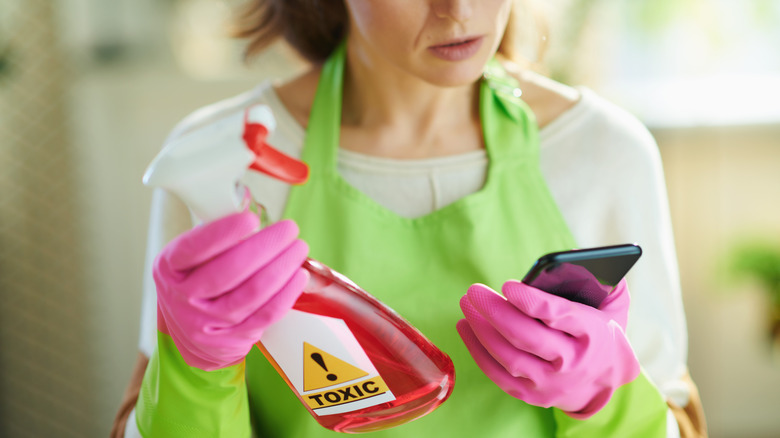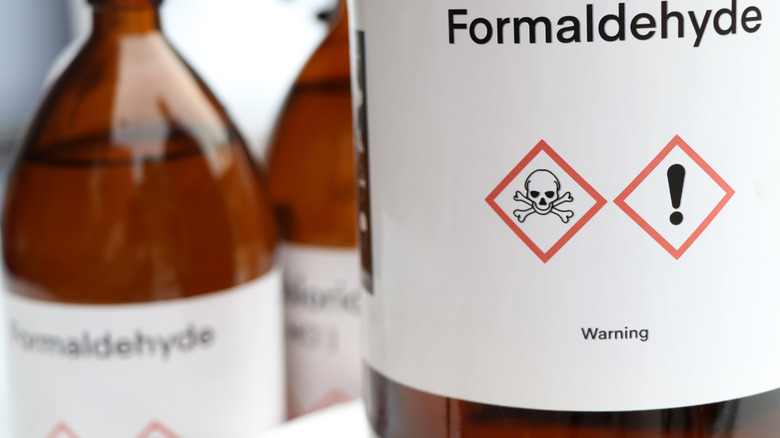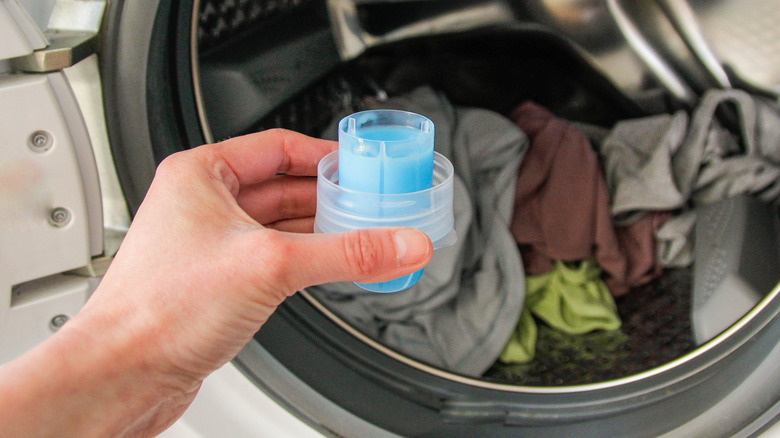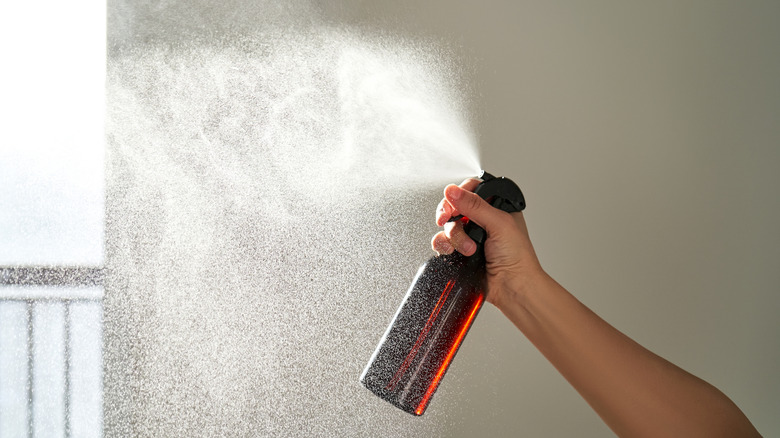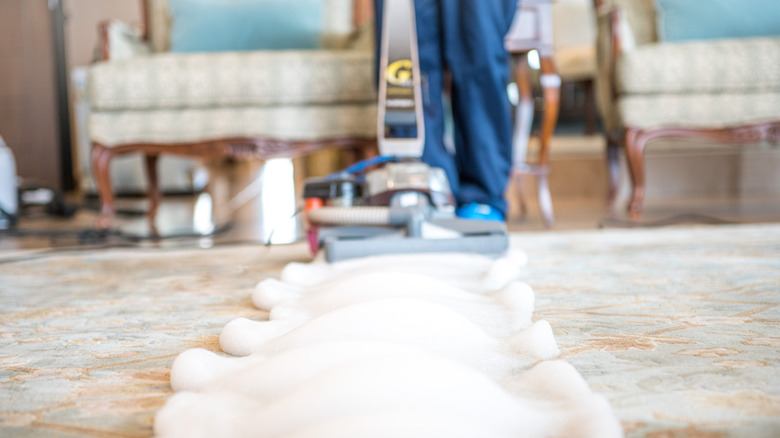Hidden Toxins In Everyday Cleaning Products
In an age of aggressive consumer advocacy, it doesn't seem like unreported and potentially dangerous chemicals could make their way into our homes in household cleaners. But it does continue to happen, mostly through a mechanism that any reader of cleaner and cosmetic labels is probably already suspicious of: underspecified fragrance-related ingredients. In some cases, the fact that a product smells good can mean it's more toxic than other options.
Companies aren't required to list all the chemicals that make up cleaning products in the U.S., and even voluntary disclosure programs commonly omit the components of fragrances that are used to make cleaners smell more appealing. There are non-fragrance-related chemicals you should be wary of, to be sure, and we'll start with one of those. The presence of unspecified fragrance-enhancing chemicals in cleaning products may have you asking questions ... or buying alternative products (or, better yet, making your own, like two-ingredient miracle cleaner).
But note that avoiding fragranced products will not necessarily protect you; even "fragrance-free" or "free and clear" products can contain fragrances used to hide the smell of chemicals, and some very unpleasant toxins are hidden in the guise of fragrance or so-called "inert" ingredients.
Formaldehyde
If you've spent any time in the last couple of decades fretting over the health effects of adhesives and other building materials, you've already run across concerns about the presence and effects of formaldehyde in the home. But formaldehyde is also a fairly common ingredient in cosmetics and household cleaners, including air fresheners, which may be one of the hidden health hazards in your home (formaldehyde, phthalates, and other toxic chemicals).
The CDC's explainer on formaldehyde describes it as an irritant when inhaled in concentrations as low as .1 parts per million (ppm), capable of causing neurological effects and asthma. Changes in lung function can result from breathing concentrations as low as .6 ppm. The Department of Health and Human Services classifies formaldehyde as a known carcinogen. Not the sort of stuff you'd probably expect to find in dishwashing liquid and laundry detergent. The Environmental Working Group (EWG) gives formaldehyde its worst hazard score (which is based on the weight of evidence that ingredients pose health concerns), and has identified formaldehyde in 25 cleaning products.
These products nearly run the gamut of cleaner categories. Ajax products, for example, use formaldehyde in hand soaps, dishwashing liquid, and laundry detergent. It's also found in some Fab Ultra liquid laundry detergent, Woolite Everyday laundry detergent, Palmolive ultra concentrated dish liquid, Murphy Oil Soap all-purpose multi-surface cleaner, Murphy Oil Soap multi-use wood cleaner, and multiple scents of Fab Ultra liquid laundry detergent. Formaldehyde is used as a preservative in cleaners, and is found in fragrance-free products like Ajax 2X Ultra Free & Clear liquid laundry detergent, and Dynamo 2X Ultra liquid laundry detergent.
Lilial or butylphenyl methylpropional
The use of butylphenyl methylpropional (sometimes under the trademark Lilial) is representative of perhaps the most hidden category of toxins in cleaning products... fragrance. The synthetic floral scent is found in over 60 cleaners in spite of evidence that it presents reproductive and developmental hazards, skin irritation, and endocrine system disruptions. The European Union banned Lilial in 2022 after a ruling by the EU Commission's Scientific Committee on Consumer Safety (SCCS) classified Lilial as "carcinogenic, mutagenic or toxic to reproduction."
EWG's database lists 63 products containing Lilial, which could be a greatly underestimated figure, given industry secrecy around fragrance ingredients. Lilial is a known ingredient of tub and tile cleaners like Lysol professional disinfectant; dish soaps and detergents including Full Circle Market dish soap (lavender scent); laundry detergents like Woolite baby laundry detergent, Method 4X and 8X (multiple scents) and Mrs. Meyer's Clean Day laundry pacs (honeysuckle scent); surface cleaners such as Windex crystal rain, Windex foaming glass cleaner, Windex Original glass cleaner, and Pine-Sol Professional; fabric softeners like Full Circle Market (lavender scent); air fresheners including Glade PlugIns scented oil refills (clean linen scent), multiple scents of OdoBan disinfectant laundry & air freshener; disinfectant sprays like Lysol disinfectant spray for baby's room; and many others. It can be found in products like Arm & Hammer liquid laundry detergent that claim to be free of perfumes and dyes.
Galaxolide
Just as Lilial is a synthetic floral scent, galaxolide (hexamethylindanopyran) is a synthetic musk fragrance used in cleaners, air fresheners, and cosmetics. It is, like many hazardous chemicals found in cleaning products, a potential endocrine disruptor and skin irritant. Galaxolide contributes to both chronic and acute aquatic toxicity, notably in the Great Lakes.
Galaxolide is found in multiple scents of Pledge multi-surface cleaner with Glade and Method laundry detergent, as well as Up & Up newborn baby soft laundry detergent, Glade spray (clean linen scent), Windex (crystal rain scent), Kirkland Signature ultra clean premium laundry detergent pacs (fresh scent), Fabuloso multi-purpose cleaner (refreshing lemon scent), Up & Up oxy odor eliminator, and OxiClean baby stain temover. More than 60 products containing galaxolide were found from a single manufacturer, SC Johnson, illustrating the knowledge gap that can be created without ingredient transparency from cleaner brands.
For its part, SC Johnson called the campaign against galaxolide "internet bullying" and denies that sufficient scientific evidence exists to claim that the chemical accumulates in the environment. Nonetheless, the company eventually bowed to pressure and agreed to replace galaxolide in its products. Substantial research from the International Journal of Hygiene and Environmental Health and NeuroToxicology establishes that high levels of galaxolide in the blood is correlated to cosmetic use, accumulates in humans, and contributes to endocrine disruption, reproductive issues, and toxicity to organs.
Butoxydiglycol and other glycol ethers
While chemicals like galaxolide are controversial, butoxydiglycol is somewhat less so. Along with other glycol ethers like 2-butoxyethanol and ethoxydiglycol, butoxydiglycol is widely used in cosmetics and cleaning products. It functions as a solvent, a fragrance enhancer, and a means of controlling product viscosity. Various risk assessments in the EU and elsewhere have found butoxydiglycol to have an impact on pulmonary function, and some evidence that the chemical causes some central nervous system problems, contributes to asthma, causes liver damage, is dangerous if swallowed or inhaled, and is a respiratory irritant, a carcinogen, and a reproductive toxin. The collective weight of all those possibilities has led activists to question the wisdom of butoxydiglycol's use in household cleaners.
The EWG database lists butoxydiglycol as an ingredient in 35 products but, again, since it's a component of fragrance, this number is probably significantly underreported. You might find it in your bathroom in The Pink Stuff Miracle Laundry oxi stain remover, or in your kitchen as an ingredient in Easy-Off Fume-Free Daily oven cleaner (lemon scent) or Easy-Off heavy duty oven cleaner (multiple scents). It can find its way into your bathroom as a part of many products, including Scrubbing Bubbles antibacterial bathroom cleaner (lemon scent), Lysol Professional heavy duty bathroom cleaner concentrate, Lysol Professional disinfectant foam cleaner for multiple surfaces, Lysol bathroom cleaner (multiple scents), Tilex bathroom cleaner (lemon scent), Lysol bathroom cleaner spray (multiple scents), Tilex soap scum remover, Clorox disinfecting bathroom cleaner, and more. Elsewhere, it's a component of Easy-Off BBQ grill cleaner aerosol spray, Simple Green carpet cleaner, and more.
Diethyl phthalate
Diethyl phthalate (DEP) is a phthalate ester, and it's surprising to still find it in cleaning products, food packaging, and cosmetics, given the uproar against phthalates in recent years. There is evidence that it contributes to respiratory, developmental, and reproductive problems, including infertility; endocrine disruption, and bone and breast cancer. A 2021 study from the American Journal of Public Health linked prenatal phthalate exposure to "attention-deficit hyperactivity disorder (ADHD), other behavioral problems, adverse cognitive development including lower IQ, poorer psychomotor development, and impaired social communication." DEP is a plasticizer and fragrance fixative, and you can probably spot the keyword in our game of toxic cleaner BINGO: fragrance.
DEP is commonly used in cosmetics, but because cleaning products are largely unregulated and DEP is classified as an inert ingredient in pesticides (which may or may not be safe), there's no reliable way to know how prevalent it is in cleaners. This is despite the fact that the FDA is currently reviewing its use in the food industry.
EWG also found it in a handful of hair products, but an investigation from Women's Voices for the Earth found DEP in carpet cleaners from Formula 409, Clorox Pet Solutions, WD-40, and Hoover; Clorox products including SOS steel wool (lavender scent), Fraganzia, Clorox Healthcare, and Dispatch hospital cleaners; Calgon; and Simple Green (lavender scent).
